Energy and Exergy Analysis of a Combined Cooling Heating and Power System with Regeneration
Abstract
:1. Introduction
2. Methodology
2.1. Thermodynamic Analysis
- Pressure drops in the connecting tubes, the gas cooler, and the evaporator are neglected.
- No heat losses to the environment from the system, except for the gas cooler.
- Across the components, the change in potential and kinetic energy are negligible.
- The expansion valve or throttle valves have isenthalpic flow.
- Total mass flow rate within the system is assumed to be 1 kg/s [27].
- Recovery heat exchanger has a known effectiveness.
- Isentropic efficiency of the turbine is fixed.
- At the inlet and exit of the evaporator, the working fluid is in saturated liquid and vapor state, respectively.
2.1.1. Turbine
2.1.2. Regenerator
2.1.3. Compressor
2.1.4. Expansion Valve
2.1.5. Evaporator
2.1.6. Recovery Heat Exchanger
2.1.7. Solar Assisted Heater
2.1.8. Gas Cooler
2.1.9. CCHP System without Regeneration
2.2. Exergy Analysis
2.2.1. Exergy Analysis of the CCHP System with Regenerator
2.2.2. Exergy Analysis of Conventional CCHP System without Regeneration
3. Results and Discussion
3.1. Validation of the Thermodynamic Model
3.2. Conventional CCHP System Simulation for Various System Maximum Pressure
3.3. Effect of Gas Cooler Exit Temperature on Conventional CCHP System Performance
3.4. Effect of System Maximum Pressure on Total System Irreversibility
3.5. Effect of System Maximum Pressure on CCHP System Perfromance with Regeneration
3.6. Effect of Bleed Mass on System Performance and Total Irreversibility
3.7. Component Level Exergy Destruction Rates
3.8. Comparison of Proposed System with Conventional CCHP System
4. Conclusions
- The total irreversibility of the CCHP system with a regenerator is lower towards lower gas cooler exit temperature.
- The gas cooler contributes 37% to overall system irreversibility, followed by the regenerator (about 17%).
- The bleed mass should be kept as low as possible, thereby directly complimenting the total irreversibility of the system.
- With an increase in bleed mass (maximum 0.5 kg/s), the overall COP of the system marks the highest value (about 2.73 at 250 bar system maximum pressure and 34 °C gas cooler exit temperature).
- Thus, there should be a tradeoff between the system COP and total irreversibility in order to fix the bleed mass.
- For any given application, a CCHP system with and without a regenerator is advised to operate at a lower gas cooler exit temperature in order to produce the maximum refrigerating effect and heating output with marginal system net work.
- However, the suitable operating range of the CCHP system with a regenerator is not limited to lower gas cooler exit temperatures and compressor discharge pressures. The system can even work at a higher operating condition by compromising the COP.
Supplementary Materials
Author Contributions
Funding
Institutional Review Board Statement
Informed Consent Statement
Data Availability Statement
Acknowledgments
Conflicts of Interest
References
- Ministry of Power Government of India. Available online: https://powermin.gov.in/en/content/power-sector-glance-all-india (accessed on 14 June 2023).
- Our World in Data. Available online: https://ourworldindata.org/fossil-fuels (accessed on 14 June 2023).
- Global Carbon Emissions. Available online: https://www.co2.earth/global-co2-emissions (accessed on 14 June 2023).
- Almatrafi, E.; Khaliq, A.; Kumar, R.; Bamasag, A.; Siddiqui, M.E. Proposal and Investigation of a New Tower Solar Collector-Based Trigeneration Energy System. Sustainability 2023, 15, 7474. [Google Scholar] [CrossRef]
- El-Sayed, M.A.H. Solar Supported Steam Production for Power Generation in Egypt. Energy Policy 2005, 33, 1251–1259. [Google Scholar] [CrossRef]
- Zhai, H.; Dai, Y.J.; Wu, J.Y.; Wang, R.Z. Energy and Exergy Analyses on a Novel Hybrid Solar Heating, Cooling and Power Generation System for Remote Areas. Appl. Energy 2009, 86, 1395–1404. [Google Scholar] [CrossRef]
- White, M.T.; Bianchi, G.; Chai, L.; Tassou, S.A.; Sayma, A.I. Review of Supercritical CO2 Technologies and Systems for Power Generation. Appl. Therm. Eng. 2021, 185, 116447. [Google Scholar] [CrossRef]
- Gesteira, L.G.; Uche, J.; Cappiello, F.L.; Cimmino, L. Thermoeconomic Optimization of a Polygeneration System Based on a Solar-Assisted Desiccant Cooling. Sustainability 2023, 15, 1516. [Google Scholar] [CrossRef]
- Magro, B.; Borg, S.P. A Feasibility Study on CHP Systems for Hotels in the Maltese Islands: A Comparative Analysis Based on Hotels’ Star Rating. Sustainability 2023, 15, 1337. [Google Scholar] [CrossRef]
- Li, M.-J.; Zhu, H.-H.; Guo, J.-Q.; Wang, K.; Tao, W.-Q. The Development Technology and Applications of Supercritical CO2 Power Cycle in Nuclear Energy, Solar Energy and Other Energy Industries. Appl. Therm. Eng. 2017, 126, 255–275. [Google Scholar] [CrossRef]
- Zhang, X.-R.; Yamaguchi, H.; Fujima, K.; Enomoto, M.; Sawada, N. A Feasibility Study of CO2-Based Rankine Cycle Powered by Solar Energy. JSME Int. J. Ser. B Fluids Therm. Eng. 2005, 48, 540–547. [Google Scholar] [CrossRef]
- Linares, J.I.; Montes, M.J.; Cantizano, A.; Sánchez, C. A Novel Supercritical CO2 Recompression Brayton Power Cycle for Power Tower Concentrating Solar Plants. Appl. Energy 2020, 263, 114644. [Google Scholar] [CrossRef]
- Shi, L.; Tian, H.; Shu, G. Multi-Mode Analysis of a CO2-Based Combined Refrigeration and Power Cycle for Engine Waste Heat Recovery. Appl. Energy 2020, 264, 114670. [Google Scholar] [CrossRef]
- Guo, C.; Du, X.; Zhou, Y.; Yang, L.; Yang, Y. Supercritical CO2 Rankine Cycle Using Low and Medium Temperature Heat Sources. In Proceedings of the ASME 2013 7th International Conference on Energy Sustainability, Minneapolis, MN, USA, 14–19 July 2013; American Society of Mechanical Engineers: New York, NY, USA, 2013. [Google Scholar] [CrossRef]
- Wang, E.; Peng, N.; Zhang, M. System Design and Application of Supercritical and Transcritical CO2 Power Cycles: A Review. Front. Energy Res. 2021, 9, 723875. [Google Scholar] [CrossRef]
- Sarkar, J.; Bhattacharyya, S.; Gopal, M.R. Optimization of a Transcritical CO2 Heat Pump Cycle for Simultaneous Cooling and Heating Applications. Int. J. Refrig. 2004, 27, 830–838. [Google Scholar] [CrossRef]
- Kiran Kumar, K.; Ram Gopal, M. Experimental Studies on CO2 Based Single and Two-Phase Natural Circulation Loops. Appl. Therm. Eng. 2011, 31, 3437–3443. [Google Scholar] [CrossRef]
- Yadav, A.K.; Ram Gopal, M.; Bhattacharyya, S. CO2 Based Natural Circulation Loops: New Correlations for Friction and Heat Transfer. Int. J. Heat Mass Transf. 2012, 55, 4621–4630. [Google Scholar] [CrossRef]
- Yadav, A.K.; Ram Gopal, M.; Bhattacharyya, S. Transient Analysis of Subcritical/Supercritical Carbon Dioxide Based Natural Circulation Loops with End Heat Exchangers: Numerical Studies. Int. J. Heat Mass Transf. 2014, 79, 24–33. [Google Scholar] [CrossRef]
- Kumar Yadav, A.; Ram Gopal, M.; Bhattacharyya, S. Effect of Tilt Angle on Subcritical/Supercritical Carbon Dioxide-Based Natural Circulation Loop With Isothermal Source and Sink. J. Therm. Sci. Eng. Appl. 2016, 8, 011007. [Google Scholar] [CrossRef]
- Thippeswamy, L.R.; Kumar Yadav, A. Heat Transfer Enhancement Using CO2 in a Natural Circulation Loop. Sci. Rep. 2020, 10, 1507. [Google Scholar] [CrossRef] [PubMed]
- Kiran Kumar, K.; Ram Gopal, M. Steady-State Analysis of CO2 Based Natural Circulation Loops with End Heat Exchangers. Appl. Therm. Eng. 2009, 29, 1893–1903. [Google Scholar] [CrossRef]
- Kumar, A.; Narendran, G.; Perumal, D.A. Effects of Nanorefrigerants for Refrigeration System: A Review. Nanosci. Technol. Int. J. 2023, 14, 17–36. [Google Scholar] [CrossRef]
- Siva Reddy, V.; Kaushik, S.C.; Ranjan, K.R.; Tyagi, S.K. State-of-the-Art of Solar Thermal Power Plants—A Review. Renew. Sustain. Energy Rev. 2013, 27, 258–273. [Google Scholar] [CrossRef]
- Garg, P.; Kumar, P.; Srinivasan, K. Supercritical Carbon Dioxide Brayton Cycle for Concentrated Solar Power. J. Supercrit. Fluids 2013, 76, 54–60. [Google Scholar] [CrossRef]
- Garg, P.; Srinivasan, K.; Dutta, P.; Kumar, P. Comparison of CO2 and Steam in Transcritical Rankine Cycles for Concentrated Solar Power. Energy Procedia 2014, 49, 1138–1146. [Google Scholar] [CrossRef]
- Ravindra, V.; Ramgopal, M. Thermodynamic Analysis of a Solar Assisted Combined Cooling, Heating and Power System with Different Cooling Cycle Configurations. INAE Lett. 2018, 3, 107–113. [Google Scholar] [CrossRef]
- Khivsara, S.; Reddy, M.U.M.; Reddy, K.P.J.; Dutta, P. Measurement of Radiation Heat Transfer in Supercritical Carbon Dioxide Medium. Measurement 2019, 139, 40–48. [Google Scholar] [CrossRef]
- Harahap, T.H.; Candra, O.; Sabawi, Y.A.; Kareem, A.K.; Mohsen, K.S.; Alawadi, A.H.; Morovati, R.; Mohamed, E.M.; Khan, I.; Madsen, D.Ø. Thermodynamic Analysis and Optimization of the Micro-CCHP System with a Biomass Heat Source. Sustainability 2023, 15, 4273. [Google Scholar] [CrossRef]
- Bhuvaneshwaran, K.; Govindasamy, P.K. Technical Assessment of Novel Organic Rankine Cycle Driven Cascade Refrigeration System Using Environmental Friendly Refrigerants: 4E and Optimization Approaches. Environ. Sci. Pollut. Res. 2022, 30, 35096–35114. [Google Scholar] [CrossRef]
- Karthikeyan, B.; Saravanan, R.; Kumar, G.P. Energy and Exergy Analysis of Natural Refrigerant Pair in a Cascade System for Combined Cooling and Heating Application. In Proceedings of the 26th National and 4th International ISHMT-ASTFE Heat and Mass Transfer Conference, Chennai, India, 17–20 December 2021; Begellhouse: Redding, CT, USA, 2022; pp. 2169–2175. [Google Scholar] [CrossRef]
- Altun, A.F. A Conceptual Design and Analysis of a Novel Trigeneration System Consisting of a Gas Turbine Power Cycle with Intercooling, Ammonia–Water Absorption Refrigeration, and Hot Water Production. Sustainability 2022, 14, 11820. [Google Scholar] [CrossRef]
- Özdemir Küçük, E.; Kılıç, M. Exergoeconomic and Exergetic Sustainability Analysis of a Combined Dual-Pressure Organic Rankine Cycle and Vapor Compression Refrigeration Cycle. Sustainability 2023, 15, 6987. [Google Scholar] [CrossRef]
- Kılıç, M. Evaluation of Combined Thermal–Mechanical Compression Systems: A Review for Energy Efficient Sustainable Cooling. Sustainability 2022, 14, 13724. [Google Scholar] [CrossRef]
- Wang, J.; Zhao, P.; Niu, X.; Dai, Y. Parametric Analysis of a New Combined Cooling, Heating and Power System with Transcritical CO2 Driven by Solar Energy. Appl. Energy 2012, 94, 58–64. [Google Scholar] [CrossRef]
- Robinson, D.M.; Groll, E.A. Efficiencies of Transcritical CO2 Cycles with and without an Expansion Turbine. Int. J. Refrig. 1998, 21, 577–589. [Google Scholar] [CrossRef]
- Ahammed, M.E.; Bhattacharyya, S.; Ramgopal, M. Thermodynamic Design and Simulation of a CO2 Based Transcritical Vapour Compression Refrigeration System with an Ejector. Int. J. Refrig. 2014, 45, 177–188. [Google Scholar] [CrossRef]
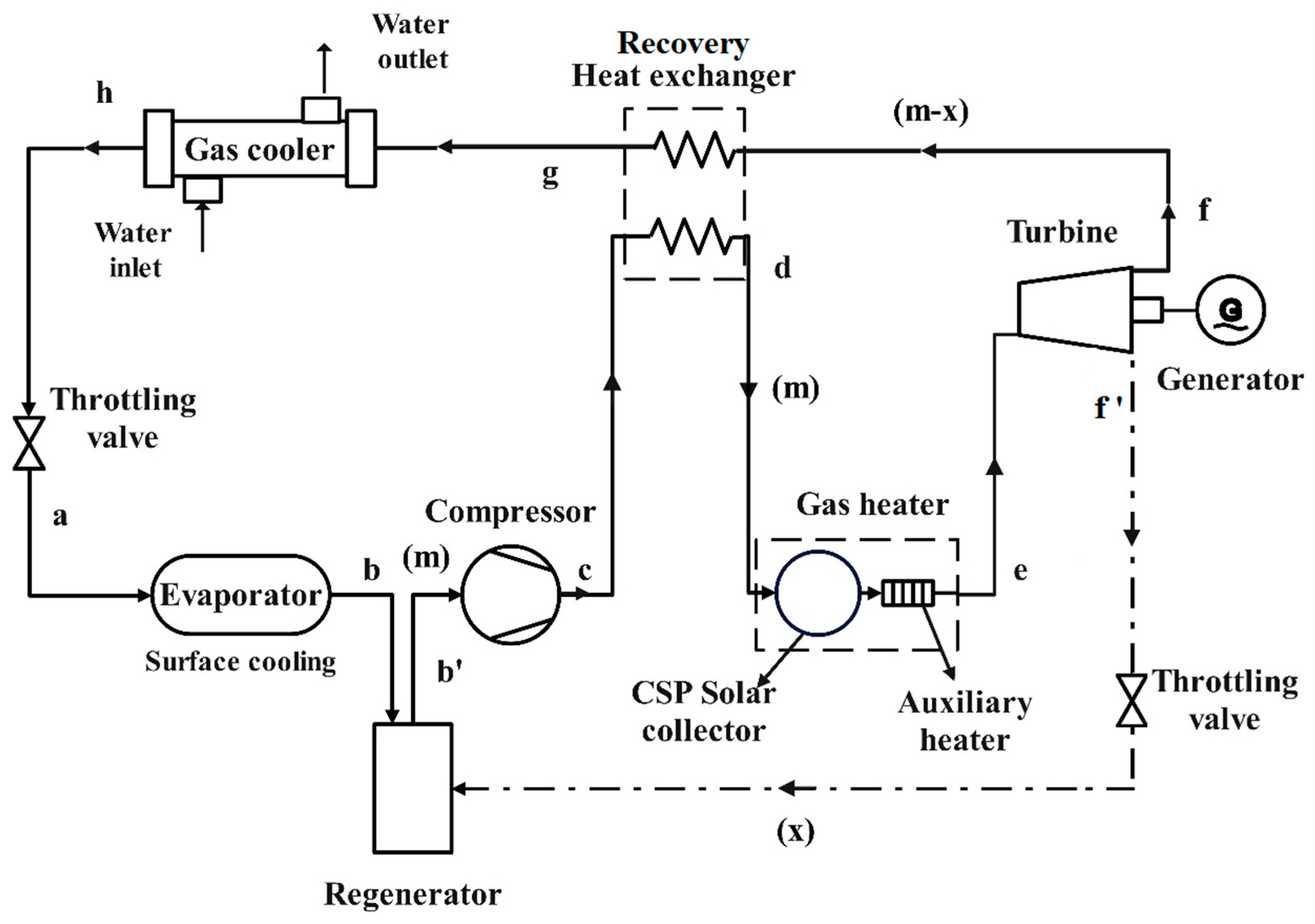


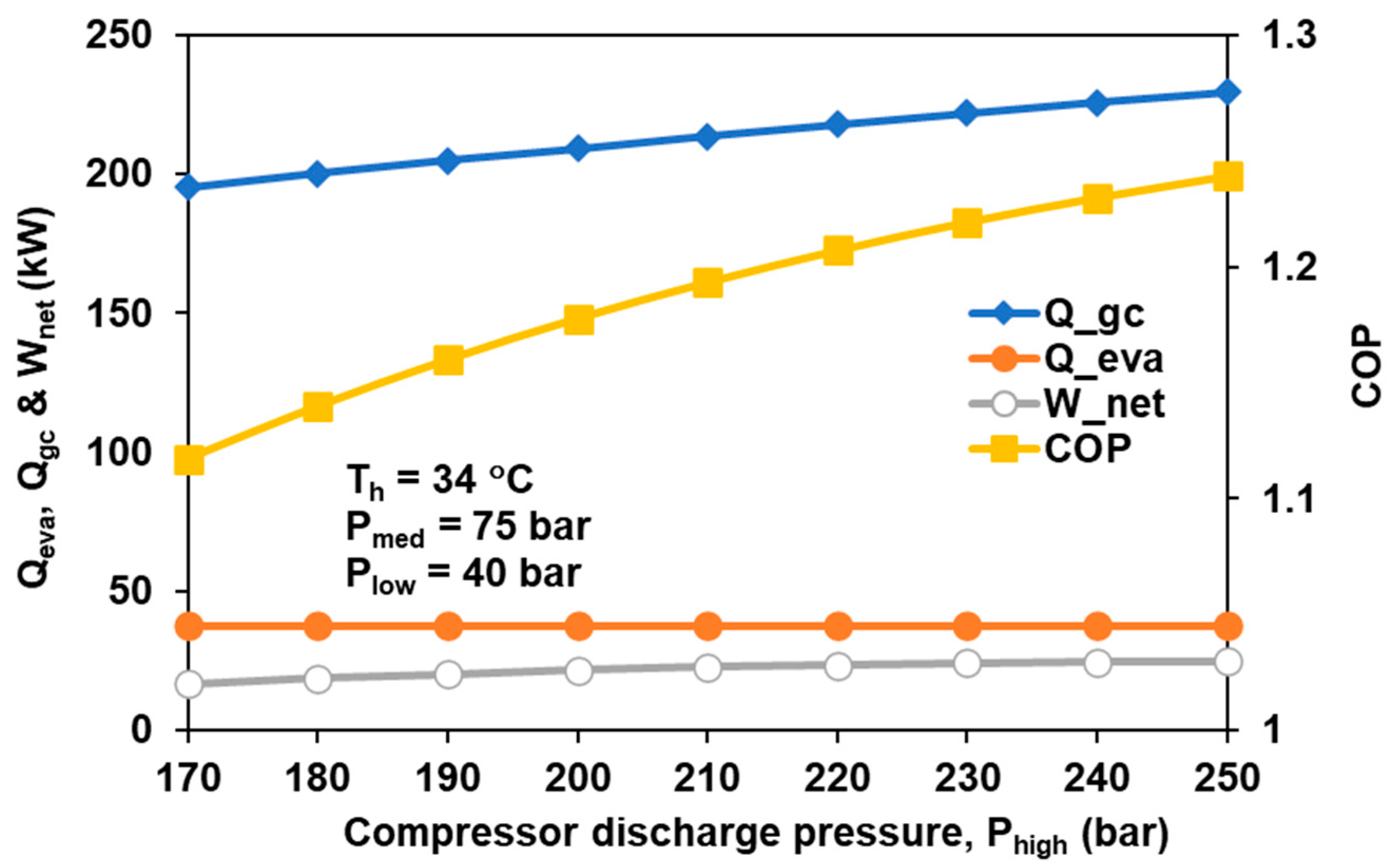
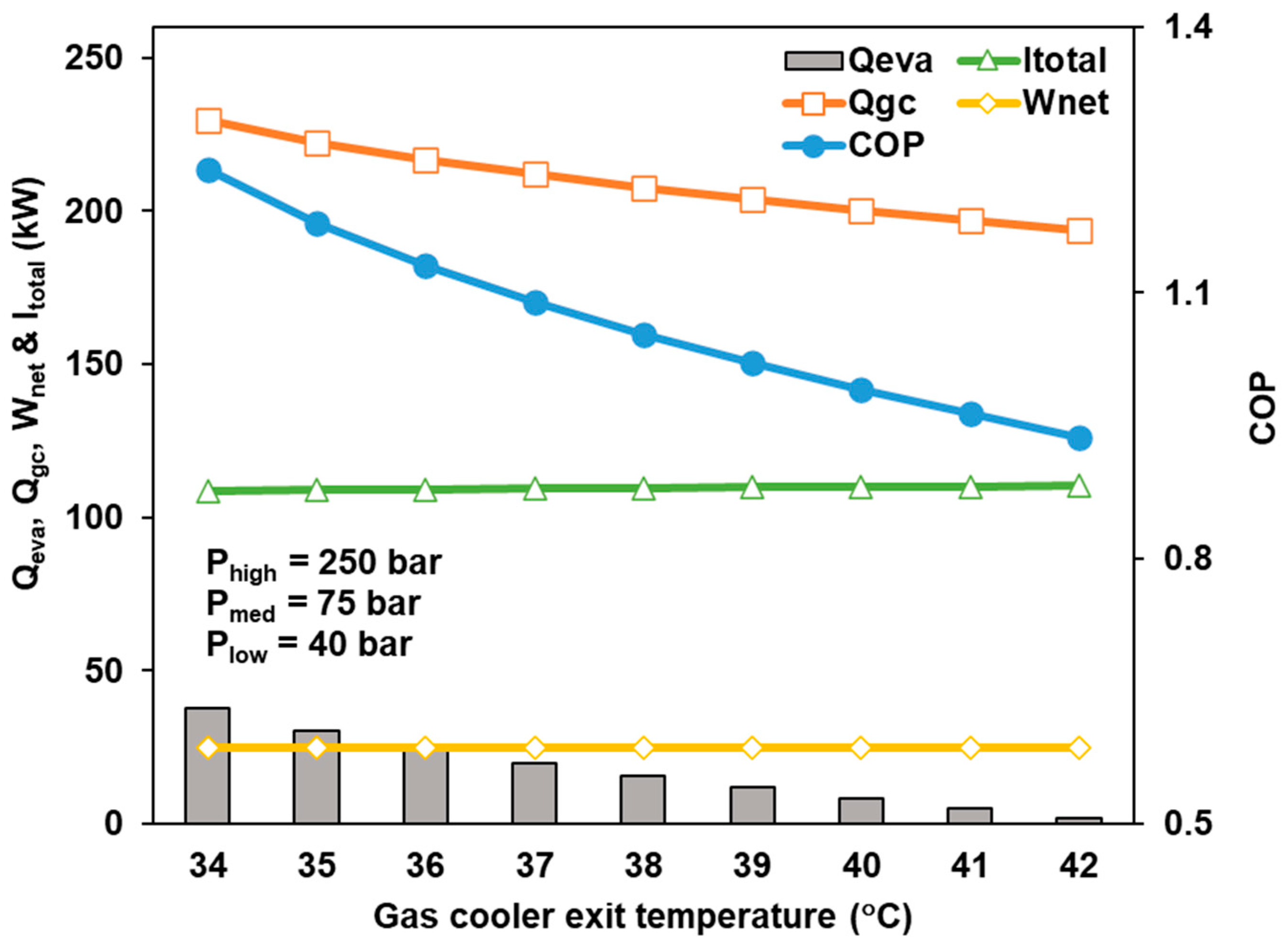
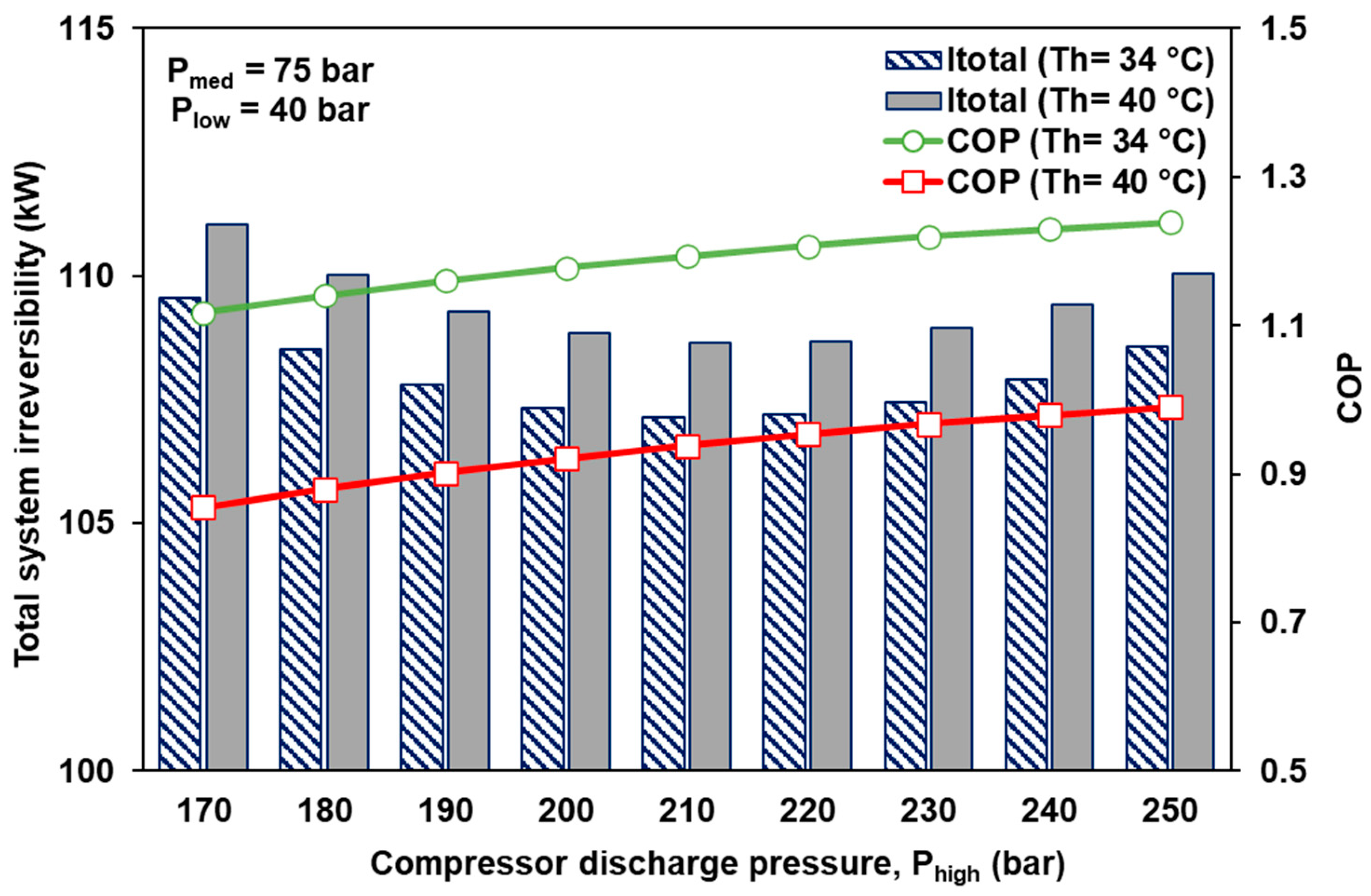
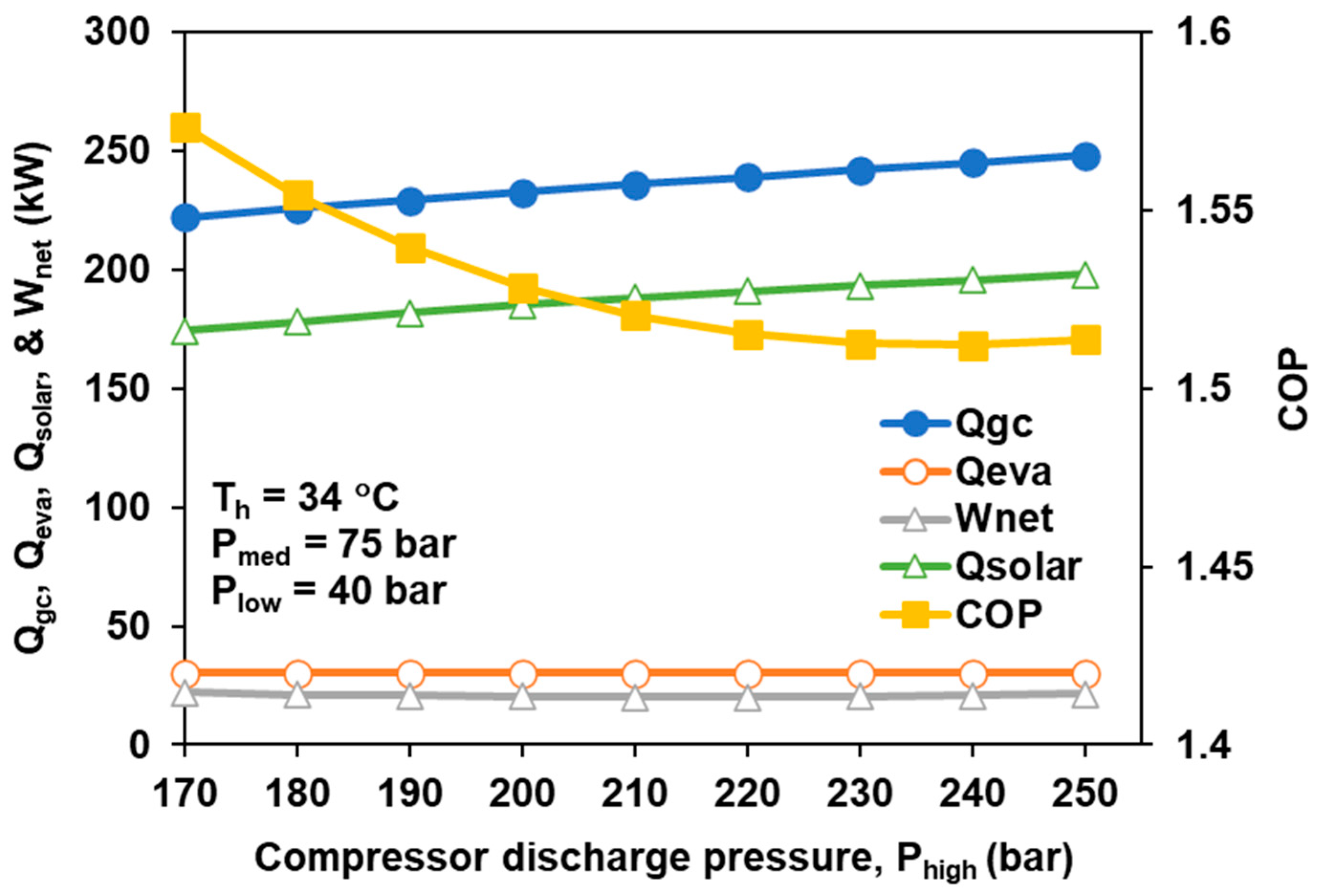

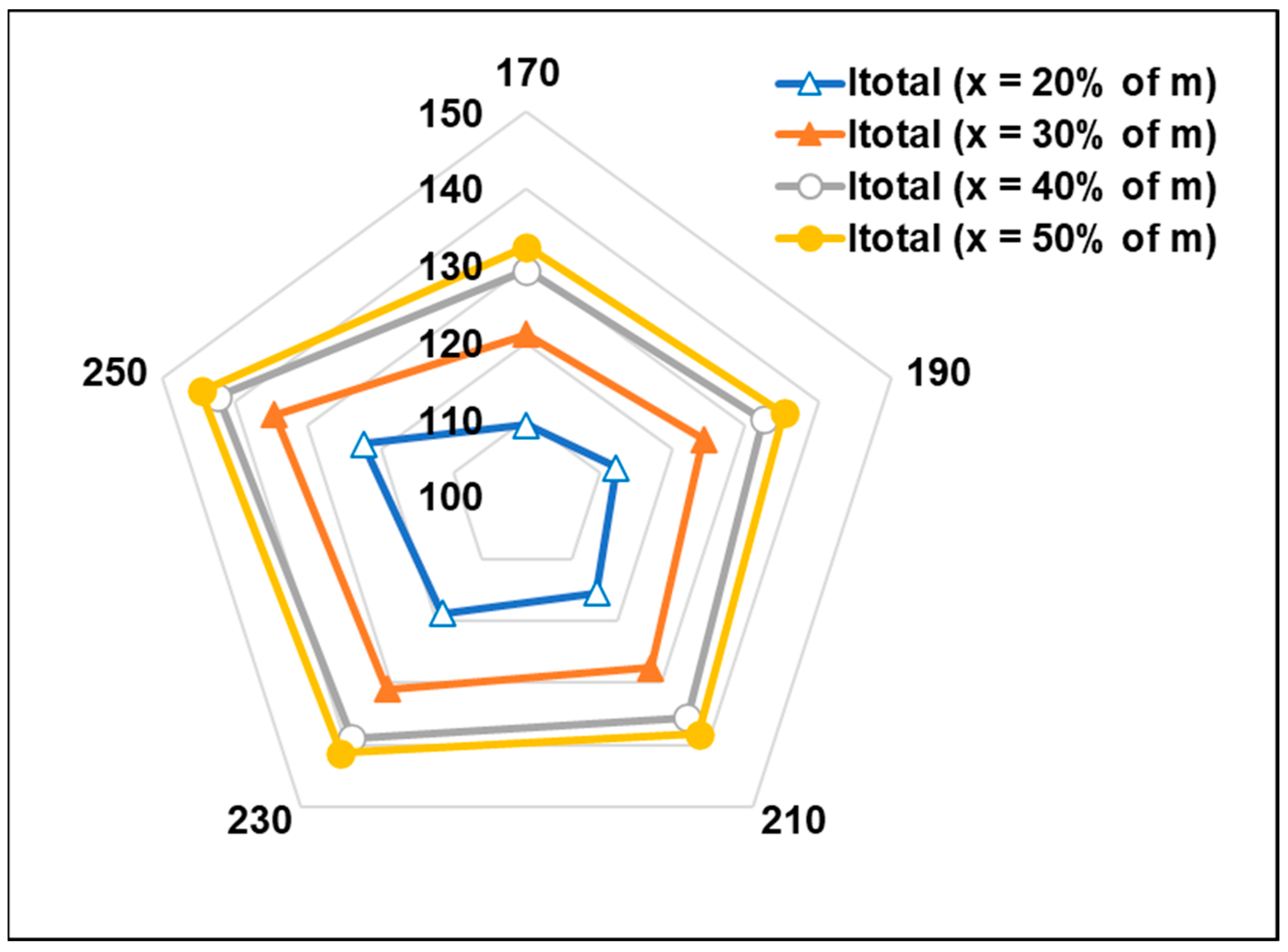
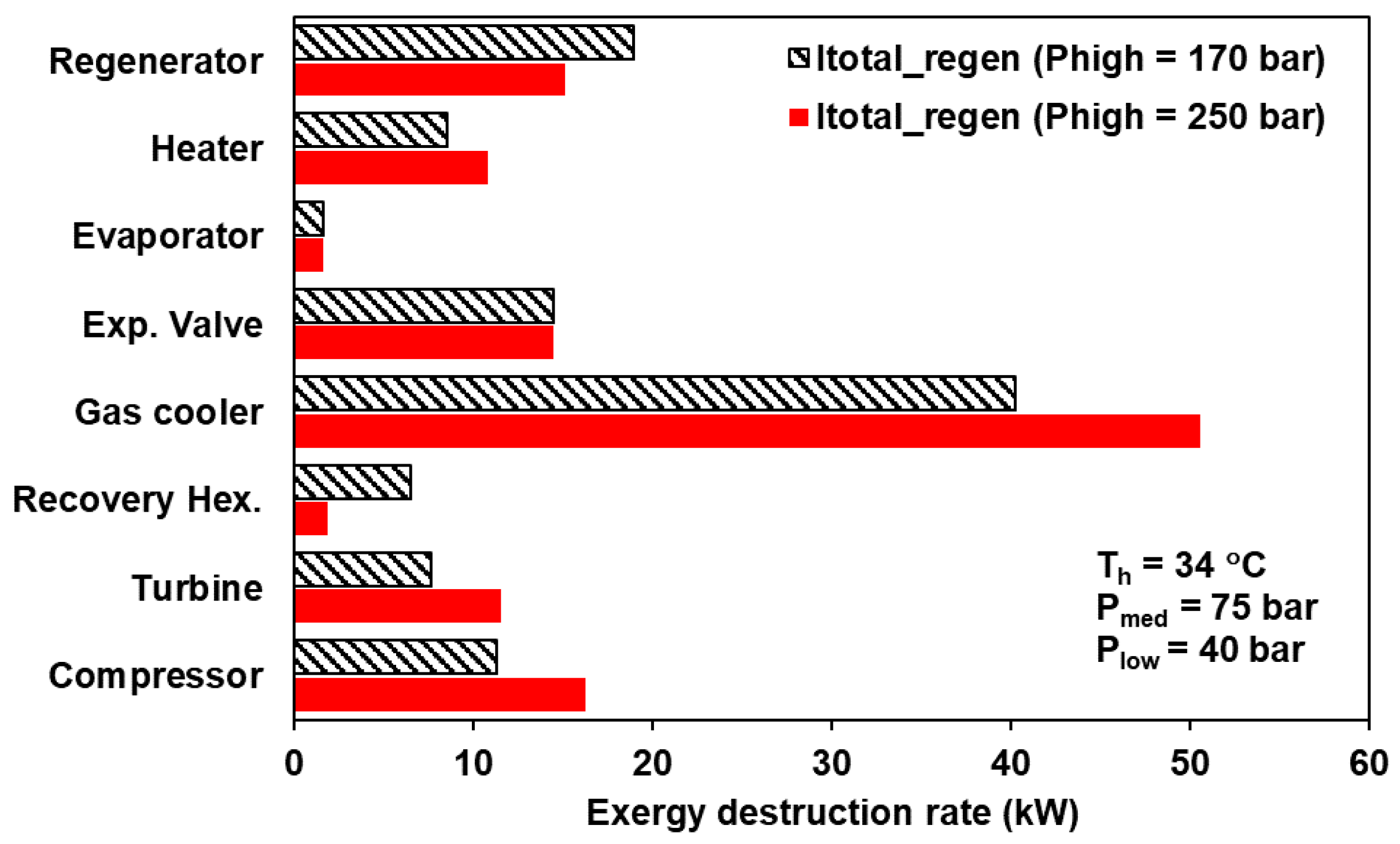
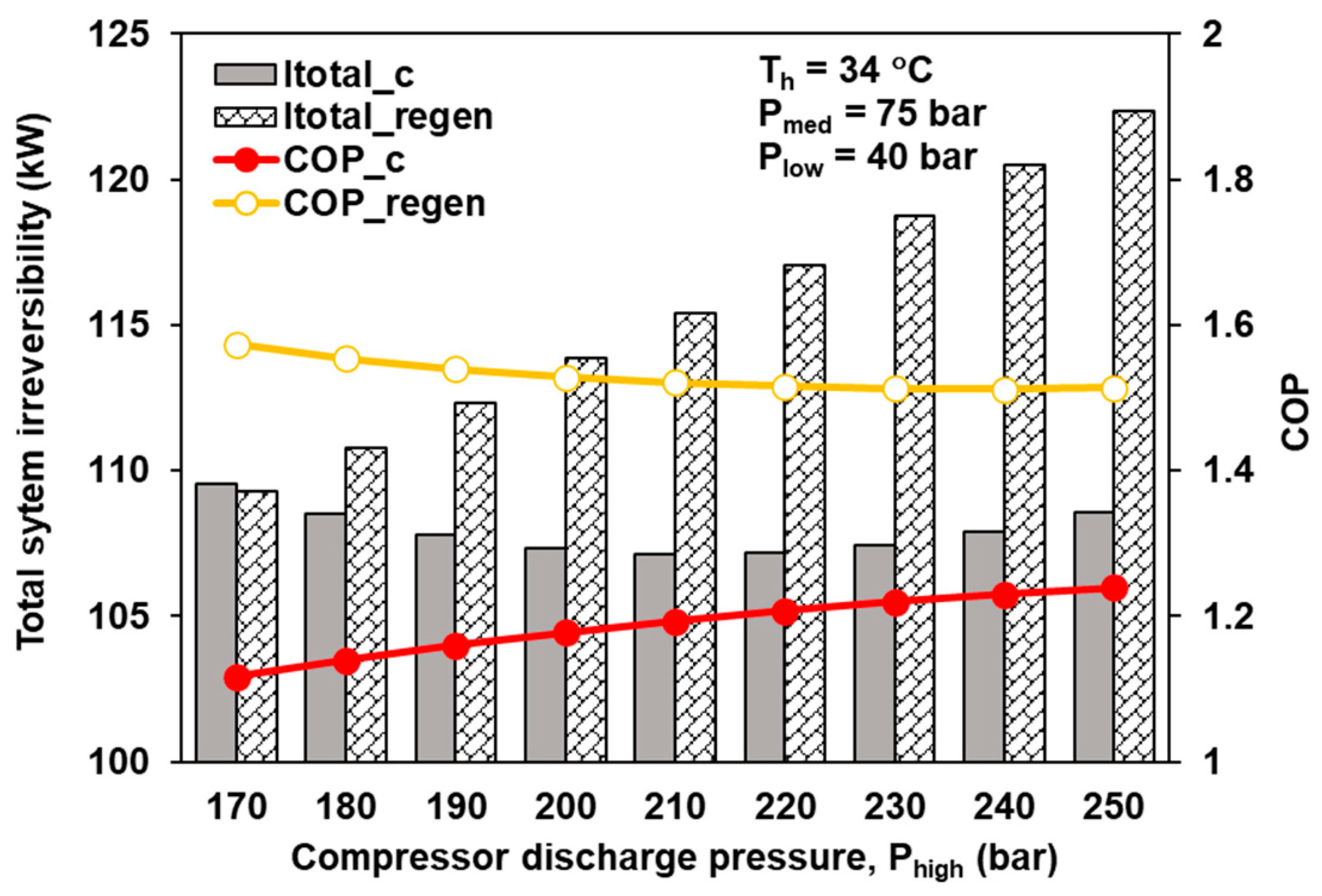
| Parameters | Fixed Values/Ranges |
|---|---|
| Isentropic efficiency of the turbine | 0.85 |
| Inlet temperature of turbine | 450 °C |
| Turbine exit pressure (Pmed) | 75 bar |
| Suction pressure of compressor (Plow) | 40 bar at 5.3 °C |
| Compressor discharge pressure (Phigh) | 250 bar/170–250 bar |
| Evaporator temperature | 5.3 °C |
| Gas cooler exit temperature | 34 °C/34–42 °C |
| Effectiveness of recovery heat exchanger | 0.9 |
| Bleed mass (x) | 0.2 kg/s/0.2–0.5 kg/s |
Disclaimer/Publisher’s Note: The statements, opinions and data contained in all publications are solely those of the individual author(s) and contributor(s) and not of MDPI and/or the editor(s). MDPI and/or the editor(s) disclaim responsibility for any injury to people or property resulting from any ideas, methods, instructions or products referred to in the content. |
© 2023 by the authors. Licensee MDPI, Basel, Switzerland. This article is an open access article distributed under the terms and conditions of the Creative Commons Attribution (CC BY) license (https://creativecommons.org/licenses/by/4.0/).
Share and Cite
Jose, J.; Parthasarathy, R.K.; Arumugam, S.K. Energy and Exergy Analysis of a Combined Cooling Heating and Power System with Regeneration. Sustainability 2023, 15, 13523. https://doi.org/10.3390/su151813523
Jose J, Parthasarathy RK, Arumugam SK. Energy and Exergy Analysis of a Combined Cooling Heating and Power System with Regeneration. Sustainability. 2023; 15(18):13523. https://doi.org/10.3390/su151813523
Chicago/Turabian StyleJose, Jobel, Rajesh Kanna Parthasarathy, and Senthil Kumar Arumugam. 2023. "Energy and Exergy Analysis of a Combined Cooling Heating and Power System with Regeneration" Sustainability 15, no. 18: 13523. https://doi.org/10.3390/su151813523
APA StyleJose, J., Parthasarathy, R. K., & Arumugam, S. K. (2023). Energy and Exergy Analysis of a Combined Cooling Heating and Power System with Regeneration. Sustainability, 15(18), 13523. https://doi.org/10.3390/su151813523








